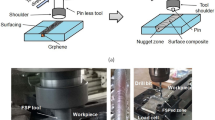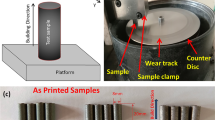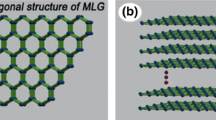Abstract
Bionic layered graphene ceramic matrix composites have excellent properties of high strength, high toughness, and heat resistance, and are important materials for national defense equipment, but they are also typical brittle and difficult-to-machine materials. To achieve high quality and low damage machining of the composite parts, grinding removal mechanism and subsurface damage are investigated in this paper. Firstly, the SPH simulation models for indentation and scratching of a single diamond grain are established. The effect of addition of graphene nanosheets on the crack expansion mechanism and subsurface damage is investigated. Then, the simulation models of different angles of graphene nanosheets are established to analyze the effect of graphene anisotropy on grinding process of composites. Finally, the grinding removal mechanism of the composites is investigated by analyzing crack expansion and removal forms of the composites at different scratching velocities and depths. The results show that incorporation of graphene nanosheets can reduce subsurface damage of composites and provide a certain shielding effect on the cracks. The optimal effects for reducing subsurface damage and cracks are obtained when graphene nanosheets angle is 0°. As scratching depth increases, the material removal mode gradually changes from plastic removal to brittle removal, and subsurface damage and crack depths also increases. The increase in scratching velocity leads to a subsequent increase in material strain rate, which inhibits crack generation and reduces subsurface damage depth. The form of material removal and crack generation in scratching experiments is consistent with the simulation analysis when changing the scratching depth. Furthermore, the effect of graphene nanosheets on crack deflection corresponds with the simulation results. This study can provide an important theoretical basis for the grinding process of bionic layered graphene ceramic matrix composite parts.















Similar content being viewed by others
References
Feng Y, Guo Y, Ling Z, Zhang X (2019) Investigation on machining performance of micro-holes EDM in ZrB2-SiC ceramics using a magnetic suspension spindle system. Int J Adv Manuf Technol 101:2083–2095. https://doi.org/10.1007/s00170-018-3116-1
Qu S, Yao P, Gong Y, Chu D, Yang Y, Li C, Wang Z, Zhang X, Hou Y (2022) Environmentally friendly grinding of C/SiCs using carbon nanofluid minimum quantity lubrication technology. J Clean Prod 366:132898. https://doi.org/10.1016/j.jclepro.2022.132898
Tian G, Li X, Dong Z, Shi T, Wang Y (2021) Temperature dependence of the electrical resistivity in ZrB2 thin film prepared by DC magnetron sputtering. Mater Lett 293:129733. https://doi.org/10.1016/j.matlet.2021.129733
Qu S, Yao P, Gong Y, Yang Y, Chu D, Zhu Q (2022) Modelling and grinding characteristics of unidirectional C-SiCs. Ceram Int 48:8314–8324. https://doi.org/10.1016/j.ceramint.2021.12.036
Li J, Zhang Y, Wang H, Fu Y, Chen G, Xi Z (2020) Long-life ablation resistance ZrB2-SiC-TiSi2 ceramic coating for SiC coated C/C composites under oxidizing environments up to 2200 K. J Alloys Compd 824:153934. https://doi.org/10.1016/j.jallcom.2020.153934
Kheyrollazadeh M, Balak Z, Azizieh M, Asl MS (2023) Effect of TaC and graphene nanoplatelets on the microstructure and mechanical properties of ZrB2. Diam Relat Mat 139:110345. https://doi.org/10.1016/j.diamond.2023.110345
Shanbhog N, Arunachalam N, Bakshi SR (2022) Effect of Graphene nanoplatelets (GNP) reinforcement on grindability of zirconium diboride ceramics. ASME J Manuf Sci Eng 144(7):071007. https://doi.org/10.1115/1.4053009
Nguyen V, Delbari SA, Asl MS, Le QV, Namini AS, Ahmadi Z, Farvizi M, Mohammadi M, Shokouhimehr M (2021) Combined role of SiC whiskers and graphene nano-platelets on the microstructure of spark plasma sintered ZrB2 ceramics. Ceram Int 47(9):12459–12466. https://doi.org/10.1016/j.ceramint.2021.01.103
Qu S, Gong Y, Yang Y, Cai M, Sun Y (2018) Surface topography and roughness of silicon carbide ceramic matrix composites. Ceram Int 44(12):14742–14753. https://doi.org/10.1016/j.ceramint.2018.05.104
Qu S, Gong Y, Yang Y, Wen X, Yin G (2019) Grinding characteristics and removal mechanisms of unidirectional carbon fiber reinforced silicon carbide ceramic matrix composites. Ceram Int 45(3):3059–3071. https://doi.org/10.1016/j.ceramint.2018.10.178
Du J, Ming W, Ma J, He W, Cao Y, Li X, Liu K (2018) New observations of the fiber orientations effect on machinability in grinding of C/SiC ceramic matrix composites. Ceram Int 44(12):13916–13928. https://doi.org/10.1016/j.ceramint.2018.04.240
Xiao C, Han B (2018) Grinding, Machining Morphological Studies on C/SiC Composites. J Inst Eng India Ser D 99(2):209–215. https://doi.org/10.1007/s40033-018-0159-2
Wen Q, Li Y, Gong Y (2023) Comparative study on micro-grinding performance of 2.5D Cf/SiCs, 2.5D SiCf/SiCs, and SiC Ceramics. Materials 16(19):6369. https://doi.org/10.3390/ma16196369
Denkena B, Bouabid A, Kroedel A (2020) Single grain grinding: a novel approach to model the interactions at the grain/bond interface during grinding. Int J Adv Manuf Technol 107(11):4811–4822. https://doi.org/10.1007/s00170-020-05219-8
Chen J, An Q, Chen M (2020) Transformation of fracture mechanism and damage behavior of ceramic-matrix composites during nano-scratching. Compos Pt A-Appl Sci Manuf 130:105756. https://doi.org/10.1016/j.compositesa.2019.105756
Mueller S, Wirtz C, Trauth D, Mattfeld P, Klocke F (2018) Material removal mechanisms in grinding of two-phase brittle materials. Int J Adv Manuf Technol 95(1):287–298. https://doi.org/10.1007/s00170-017-1184-2
Li Y, Ge X, Wang H, Hu Y, Ning F, Cong W, Ren C (2019) Study of material removal mechanisms in grinding of C/SiC composites via single-abrasive scratch experiment. Ceram Int 45(4):4729–4738. https://doi.org/10.1016/j.ceramint.2018.11.165
Duan N, Yu Y, Wang W, Xu X (2017) Analysis of grit interference mechanisms for the double scratching of monocrystalline silicon carbide by coupling the FEM and SPH. Int J Mach Tools Manuf 120:49–60. https://doi.org/10.1016/j.ijmachtools.2017.04.012
Shi D, Hou Q, Ma T, Zhao T, Pan J (2022) Analysis of the high-efficiency and low-damage abrasive processing mechanism for SiC based on the SPH simulation of single-grain indentation and scratching. AIP Adv 12(5):055001. https://doi.org/10.1063/5.0076269
Liu Y, Li B, Wu C, Zheng Y (2016) Simulation-based evaluation of surface micro-cracks and fracture toughness in high-speed grinding of silicon carbide ceramics. Int J Adv Manuf Technol 86:799–808. https://doi.org/10.1007/s00170-015-8218-4
An YM (2016) Research on the microstructure regulation and properties of graphene/ZrB2 ceramic composites. Dissertation, Harbin Institute of Technology.
Ren X, Zhang H, Zhang J, Yu S, Maimaitiyusupu S (2023) Numerical Simulation Analysis of Fracture Propagation in Rock Based on Smooth Particle Hydrodynamics. Materials 16(19):6560. https://doi.org/10.3390/ma16196560
Limido J, Espinosa C, Salaün M, Lacome JL (2007) SPH method applied to high speed cutting modelling. Int J Mech Sci 49(7):898–908. https://doi.org/10.1016/j.ijmecsci.2006.11.005
Islam MRI, Peng C (2019) A Total Lagrangian SPH method for modelling damage and failure in solids. Int J Mech Sci 157:498–511. https://doi.org/10.1016/j.ijmecsci.2019.05.003
Li M, Guo X, Zhai R, Luo X, Kang R, Jin Z, Guo D (2021) Study on the Subsurface Damage Mechanism of Optical Quartz Glass during Single Grain Scratching. Ceram Int 47(6):7683–7691. https://doi.org/10.1016/j.ceramint.2020.11.111
Huang Y, Jiang D, Zhang X, Liao Z, Huang Z (2018) Enhancing toughness and strength of SiC ceramics with reduced graphene oxide by HP sintering. J Eur Ceram Soc 38(13):4329–4337. https://doi.org/10.1016/j.jeurceramsoc.2018.05.033
Meng X, Xu C, Xiao G, Yi M, Zhang Y (2016) Microstructure and anisotropy of mechanical properties of graphene nanoplate toughened Al2O3-based ceramic composites. Ceram Int 42(14):16090–16095. https://doi.org/10.1016/j.ceramint.2016.07.121
Bordinassi EC, Seriacopi V, dos Santos MO, Paschoalinoto NW, de Farias A (2023) Effect of cryogenic cooling on residual stresses and surface finish of 316L during hybrid manufacturing. Int J Adv Manuf Technol 129:1489–1502. https://doi.org/10.1007/s00170-023-12380-3
Ivanov S, Turichin G (2023) Residual stress and strain mitigation in direct laser deposition through adjustment buildup geometry or addition of ductile transition layer. Int J Adv Manuf Technol 128:3317–3329. https://doi.org/10.1007/s00170-023-12149-8
Qi Y, Liu J, Zhang J, Dong Y, Li Q (2017) Wear resistance limited by step edge failure: The rise and fall of graphene as an atomically thin lubricating material. ACS Appl Mater Interfaces 9(1):1099–1106. https://doi.org/10.1021/acsami.6b12916
Funding
This work was supported by the National Natural Science Foundation of China (Grant No. 51905083 and 51975113), the Natural Science Foundation of Hebei Province (Grant No. E2022501004 and E2021501027), the Fundamental Research Funds for the Central Universities (Grant No. 2023GFYD002), China Postdoctoral Science Foundation (Grant No. 2021MD703912).
Author information
Authors and Affiliations
Contributions
All authors made contributions to this study. Ji Zou designed and conducted the experiments and completed the original manuscript. Yunguang Zhou provided fundamental ideas and provided financial support. Chunxue Zhang and Dezhen Li have modifed the language and made some critical revisions. Lianjie Ma and Ming Li assisted the trial and analysis.
Corresponding author
Ethics declarations
Consent for publication
All authors have read this manuscript and approved the manuscript for publication.
Competing interests
The authors declare no competing interests.
Additional information
Publisher's Note
Springer Nature remains neutral with regard to jurisdictional claims in published maps and institutional affiliations.
Rights and permissions
Springer Nature or its licensor (e.g. a society or other partner) holds exclusive rights to this article under a publishing agreement with the author(s) or other rightsholder(s); author self-archiving of the accepted manuscript version of this article is solely governed by the terms of such publishing agreement and applicable law.
About this article
Cite this article
Zhou, Y., Zou, J., Zhang, C. et al. Study on grinding removal mechanism and subsurface damage of bionic layered graphene ceramic matrix composites. Int J Adv Manuf Technol 130, 3837–3849 (2024). https://doi.org/10.1007/s00170-023-12897-7
Received:
Accepted:
Published:
Issue Date:
DOI: https://doi.org/10.1007/s00170-023-12897-7




